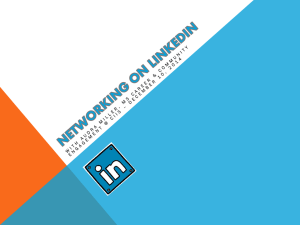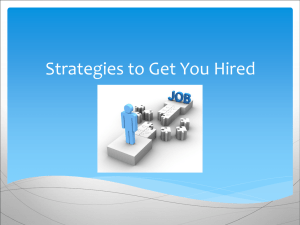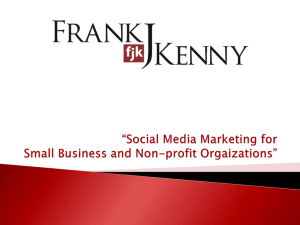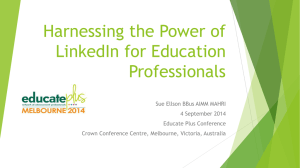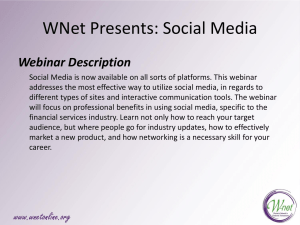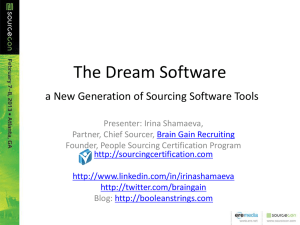Talking about yourself on LinkedIn: Pronoun choices
advertisement
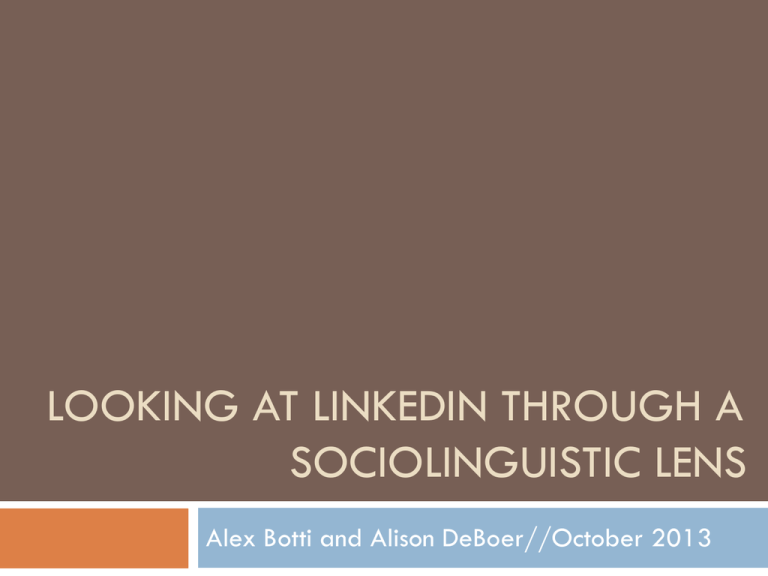
LOOKING AT LINKEDIN THROUGH A SOCIOLINGUISTIC LENS Alex Botti and Alison DeBoer//October 2013 Introduction • Who we are • What we’ve been doing • What our goals are • Help from you! What we’ll cover 1. Introduction to LinkedIn 2. Contributions from a sociolinguistic perspective (what might others overlook?) • Profile as narrative: a framework • Identity (“getting personal”) • Referring terms 3. Next steps LinkedIn 101 LinkedIn was launched in 2003 (before FB!) 225 million members in 200 countries Mission statement: “Our mission is simple: connect the world's professionals to make them more productive and successful. When you join LinkedIn, you get access to people, jobs, news, updates, and insights that help you be great at what you do.” A view of my LinkedIn homepage Invitations to connect Menu bar Info/suggestion from LinkedIn Profile views Suggested connections Status update News feed Info about recent activity on the site and info about my connections A view of my LinkedIn profile Components of a profile Summary Experience Skills and Expertise Education Projects Languages Publications Groups Interests Courses Test scores Patents Certifications Volunteering and Causes Recommendations Sociolinguistic Lens The Data 71 profiles Viewed as “public” for quantitative analysis Coded for Age, Gender, Industry # of connections, recs, sections & words used Location (by country) Qualitative analysis looking at identity and selfpresentation work Framework: Profiles as narratives Analyzing profiles as we would narratives: • • • • • • Audience Story progression Identity and self-presentation/performance Lexical choices Role of interaction More… LinkedIn Narratives LinkedIn Narratives Framework: Profiles as narratives Zooming in on: • Identity and self-presentation (the personal) • Lexical choices/referring terms Socio lens: Identity and self-presentation SO WHAT? Why does this data matter? A virtual you is out there…others can get to it before they get to you! Who is printing out your LinkedIn profile? Where does the personal come in? LinkedIn’s version of “personal” information, vs. the user’s: linguistic choices people make infuse personality and identity into the profile A model of “3 Rs”: framework for looking at how the choices people make convey – or have the power to convey – an identity, something beyond a simple online resume The “3 Rs”: Reading LinkedIn through a personal lens Reading: Headline: specific or broad? What do people call themselves? Buzzwords: Clues across a profile on how to approach and interact The “3 Rs”: Representing yourself – personally – on LinkedIn Representing: LinkedIn as part of a constellation of connections: an online footprint What The makes you tick/passions: what others will read “why” of your background LinkedIn Narratives The “3 Rs”: Reaching out and staying personal while doing it Reaching out: Personal Staying invites: shared history top of mind: generous interaction Now what? A framework for soliciting feedback on and exploring your own “LinkedIn self”! Research: Talking about yourself via pronoun choices I evaluate domestic and international credentials… Evaluate domestic and international credentials… Evaluates domestic and international credentials… She evaluates domestic and international credentials… Alison evaluates domestic and international credentials… We evaluate domestic and international credentials… Domestic and international credential evaluation… Research: Talking about yourself via pronoun choices Questions for you… -What do you think each of these connotes? -What pronouns/referring expressions do you use in your profile? -Do you have a preference for one? -Does the language related to pronouns/referring expressions differ in your resume versus your LinkedIn profile? How so? -Do you use pronouns differently in different sections of profile (i.e. summary versus experience)? Research: Talking about yourself via pronoun choices From our pilot study… In Summary section: 36% use no pronouns (credential evaluation) 27% use first person (I evaluate credentials) 18% total use implied first or third person (evaluate(s) credentials In Experience section: 45% use no pronouns (credential evaluation) 7% use first person (I evaluate credentials) 30% total use implied first or third person (evaluate(s) credentials) What’s next? Next RQs (using this model) Research Questions How do goals (i.e. searching for a new job, noting emerging industry trends) shape the choices people make in presenting themselves linguistically, and how do these shift over time? How does the “request to connect” and other such online requests shape offline encounters where identity is performed in relation to other's public faces? How is LinkedIn talked about in other spaces/platforms? Contributions from you Thank you!
